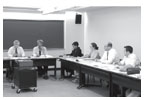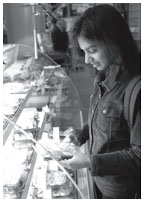The Task Force on Health and Well Being at work. Among its 18 members were, from left to right, co-chairs Bob Durkee ’69, Vice President and Secretary, and Janet Dickerson, Vice President for Campus Life; Terri Harris Reed, Associate Provost for Institutional Equity; graduate student Rachel Kimbro; Jonathan Baer, Director of Building Services; and graduate student Ian Parrish.
Junior Vinitha Jacob investigates the sushi at the new Healthy Eating Lab in the Frist Campus Center.
Working out at the Stephens Fitness Center in Dillon Gym. |
Taking Princeton’s Pulse
The health of a university community should be measured by the academic performance of its faculty and students, the productivity of its staff, and the accomplishments and loyalty of its alumni. Yet, as all of us know, our ability to thrive professionally and personally depends on the state of our minds and bodies—the complex engines that propel us through life. It is easy to acknowledge this fact in the abstract, but all too often the pressures of day-today existence—the competing demands of workplace and home or academics and extracurricular activities—prevent us from taking stock of our physical and mental needs and those of the men and women around us.
In the fall of 2003, I commissioned a task force headed by Vice President for Campus Life Janet Dickerson and Vice President and Secretary Bob Durkee ’69 to evaluate these needs at Princeton. Composed of faculty, staff, and undergraduate and graduate students, the Task Force on Health and Well Being recently issued its final report, a 38-page blueprint for “healthy” change throughout the University. The subjects addressed in this report range from mental healthcare for students to childcare, and from staffing to facilities, but all are examined within a common philosophical framework.
In its own words, “The task force believes that as an educational institution, a residential community, and an employer eager to attract, retain, and motivate the best possible faculty and staff, Princeton University should seek to provide a campus environment and a range of programs that sustain and enhance the physical, psychological, and emotional health of undergraduates, graduate students, post-docs, faculty, and staff, and that assist them in achieving an appropriate balance between work and personal/family life.”
Before describing some of the task force’s major recommendations, as well as a number of steps already taken, I would like to talk about the genesis of this initiative. To begin with, I am deeply indebted to Dr. Nancy Newman ’78, who chairs the Trustees’ Committee on Student Life, Health, and Athletics, for her forceful advocacy of our students’ health-related needs. A neuro-ophthalmologist at Emory University’s School of Medicine and a graduate of Harvard Medical School, Dr. Newman has raised our awareness of the multidimensional nature of student healthcare—from the provision of clinical services to the promotion of healthy lifestyles. I am also grateful for the energetic leadership of Dr. Daniel Silverman, Princeton’s chief medical officer and executive director of University Health Services. Since joining our staff in 2002, Dr. Silverman has implanted a holistic vision of what it means to foster health in a university community, reminding us that needs take many forms and that an integrated approach to them, with mutually reinforcing services, is the surest prescription for success.
However, insofar as a picture is worth a thousand words, it was my visits to McCosh Health Center and Dillon Gym that dramatized the need for a thorough assessment of our collective health and well being. These two facilities, which date from 1925 and 1947 respectively, have served our campus well, but as the task force noted, they are “straining at the seams” today. Over the past six years, the number of interactions between patients and University Health Services personnel has increased by more than 42 percent, with the sharpest spike occurring in calls for after-hours urgent care. The dedication of our healthcare providers, bolstered by the equally devoted Auxiliary to the Isabella McCosh Infirmary, has done much to offset the physical limitations of our medical facilities, but even without the planned expansion of the undergraduate student body a program of renewal is in order. Dillon Gym is also overstretched, as anyone who has flexed their muscles in the Stephens Fitness Center or peered through its leaded windows knows. Generations of athletes and recreational users have given the entire building a workout, and significant improvements will be needed if Dillon Gym is to be an effective and attractive provider of fitness, physical education, and intramural athletic programs.
Space is also in short supply at Princeton’s two universityaffiliated childcare centers, U-Now and U-League, which brings me to the final impetus behind the task force. In the fall of 2003, the Task Force on the Status of Women Faculty in the Natural Sciences and Engineering at Princeton released a report that highlighted the challenges that many female professors face in fulfilling both their familial and professional obligations. It found that a shortage of affordable and accessible childcare was among the foremost of these challenges, and improvements in this sphere, designed to benefit both faculty and non-faculty, headed the task force’s list of “family-friendly” recommendations. As someone who has had to balance the needs of two young children and the requirements of a demanding scientific career, I know how important childcare programs are to both solving logistical problems and fostering peace of mind. I am delighted, therefore, that the Task Force on Health and Well Being, working with Bright Horizons, a highly regarded firm of childcare consultants, has conducted a comprehensive needs assessment and set forth concrete proposals to address this crucial problem.
It would take more than two pages to describe the task force’s wide-ranging recommendations in this and other areas, to say nothing of the actions we have already taken to improve the health and well being of our university community. Nor can I do justice to or sufficiently thank the task force for the long hours of investigation and analysis that underpin its final report. I also appreciate the critical contributions of everyone who completed a survey (some 6,000 respondents in all, not including those who answered a separate Bright Horizons’ questionnaire), participated in a focus group, or shared their expertise. The full report can be found at www.princeton.edu/hwbtf/reports. shtml, but here is a sampling of its principal recommendations, as well as some recent initiatives. • Increase the staff of University Health Services to include an additional physician and urgent care nurse and additional staffing for health education and promotion. Staffing levels have remained relatively constant over the past decade, despite a significant growth in demand, and though the quality of healthcare offered to our students is very high, Princeton can and should do better vis-à-vis its peers in terms of extending and easing access to this care.
• Enhance the student health plan by reimbursing 80 rather than 50 percent of the cost of outpatient mental healthcare services and by increasing the number of visits covered in a given year from 24 to 30. This is consistent with improvements to our employee healthcare plans, which now allow for twice as many consultations in the event of mental illness as they did last year. In addition, effective this past fall, we have arranged for Carebridge Corporation, a leading provider of employee assistance and worklife programs, to provide our faculty and staff, as well as members of their families, with round-the-clock personal counseling on issues ranging from workplace relationships to substance abuse. There is a growing awareness in our society that mental illness deserves the same level of attention as physical ailments, and I am happy that Princeton is taking steps to address imbalances in coverage, as well as to reduce the stigma that may have hitherto deterred some students and employees from seeking help.
• Under the banner of “A Healthier Princeton,” develop an integrated program of health promotion and education, coupled with disease detection and prevention, for University employees. Faculty and staff have welcomed initiatives such as FluFest (not this year, alas!), Cirque de Santé, which tests blood pressure, and HeartSmart, which identifies behaviors and conditions associated with heart attacks and strokes, and there is every reason to believe that an expansion of such programs will yield both individual and institutional dividends as health risks and health costs are lowered. Rates of absenteeism and “presenteeism,” when employees come to work but are unable to function properly, can also be reduced by programs that include such elements as exercise classes, nutritional counseling, weight and stress management, and appraisals and screenings designed to prevent or control a wide variety of ailments.
• Meet the fitness needs of students and employees by renovating and enlarging Dillon Gym, and, in the interim, by expanding its hours of operation, improving the level of maintenance, and replacing fitness equipment on a regular basis. Building Services has already identified more than 70 ways of enhancing the attractiveness of Dillon Gym and instituting longpostponed repairs, and the task force hopes that these and other steps will be the prelude to a new and exciting chapter in the life of this facility.
• Respond to the nutritional concerns of all sectors of our university community by maintaining and expanding the newly established “Healthy Eating Lab” in the Frist Campus Center, which features foods that are high in nutrients and vitamins but low in fats and calories. The Lab, which also offers guidance in preparing healthful foods, has been a hit since it opened its doors in the fall, serving more than 400 customers a day. The appointment of a full-time clinical nutritionist as part of the proposed expansion of University Health Services, as well as changes in the ways that Dining Services prepares and presents its food, should also contribute to healthier consumption patterns, weight loss, and reductions in eating disorders.
• Address the physical constraints that now impede the delivery of services at both Dillon Gym and McCosh Health Center, and do so in a way that integrates complementary programs and resources. The survey conducted by the task force found widespread support for a facility that could offer a broad continuum of services, “from health services and health promotion through fitness, wellness, and physical education programs and recreational athletics.” Accordingly, the task force has encouraged the University to explore the future configuration of both facilities with such synergies in mind.
• Broaden access to childcare by improving the communication and coordination of resources in this field, both in terms of childcare facilities, such as U-Now and U-League, and institutional policies, such as flextime and tenure review extensions. The task force has initiated a fruitful dialogue with U-Now and U-League, which should lead to enhancements in service and capacity. However, it also believes that the needs of parents cannot be met without a major expansion of on-campus childcare, especially for infants and toddlers. Therefore, in consultation with Bright Horizons, the task force has recommended that the University establish a new childcare center to complement the work of U-Now and U-League, creating 160 additional spaces, as well as “school’s out” and “back-up” care. This would entail the construction of a new facility, possibly in concert with new accommodations for U-Now and U-League, whose current quarters have serious drawbacks.
The proposals of the task force are compelling in their scope and detail,
and they deserve the broadest possible hearing in the months ahead. Their
implementation will require time, resources, and good will, but as the
findings of the task force attest, our university community is committed
to creating a healthier Princeton in every sense of the word. ![]()





